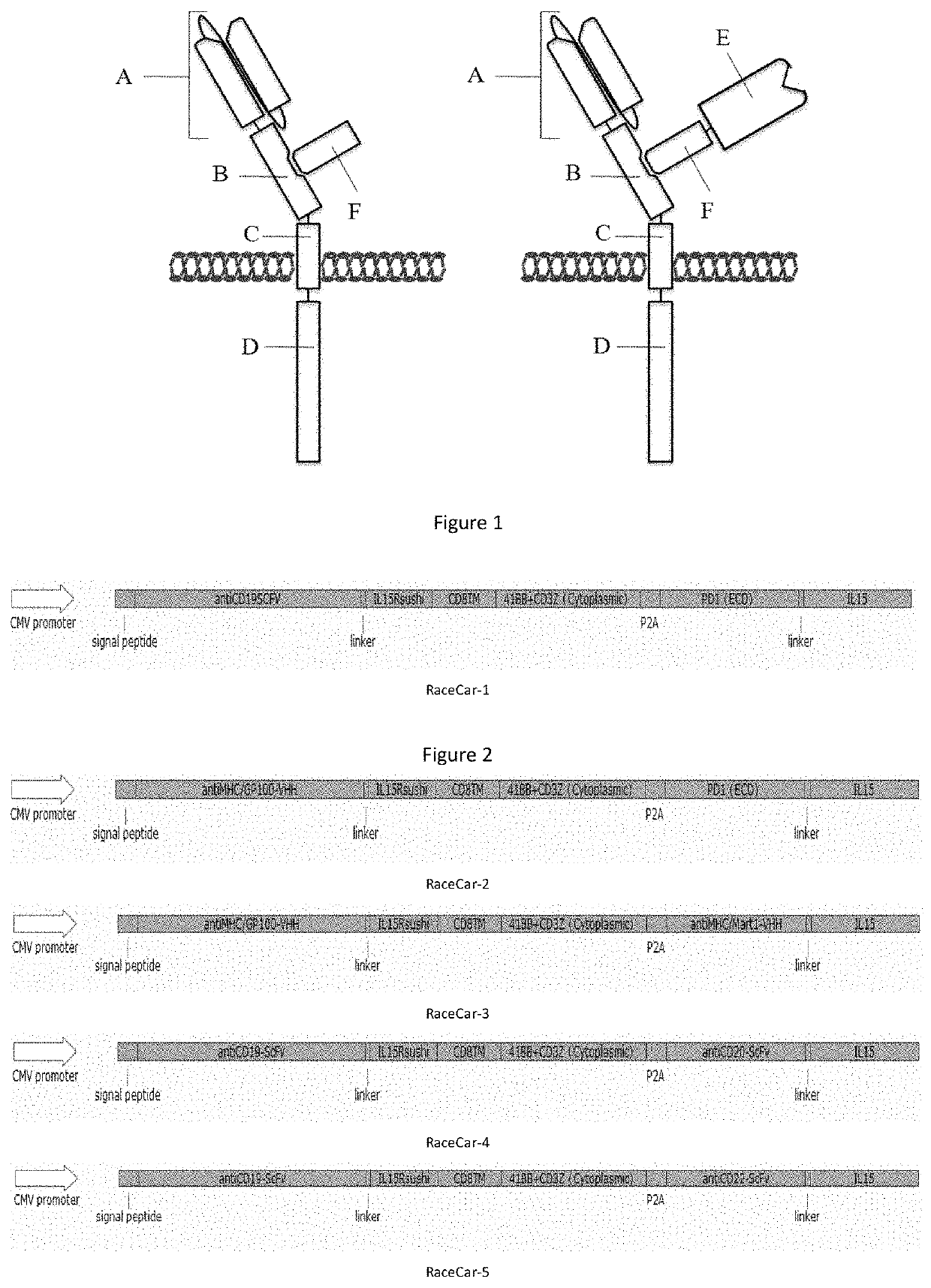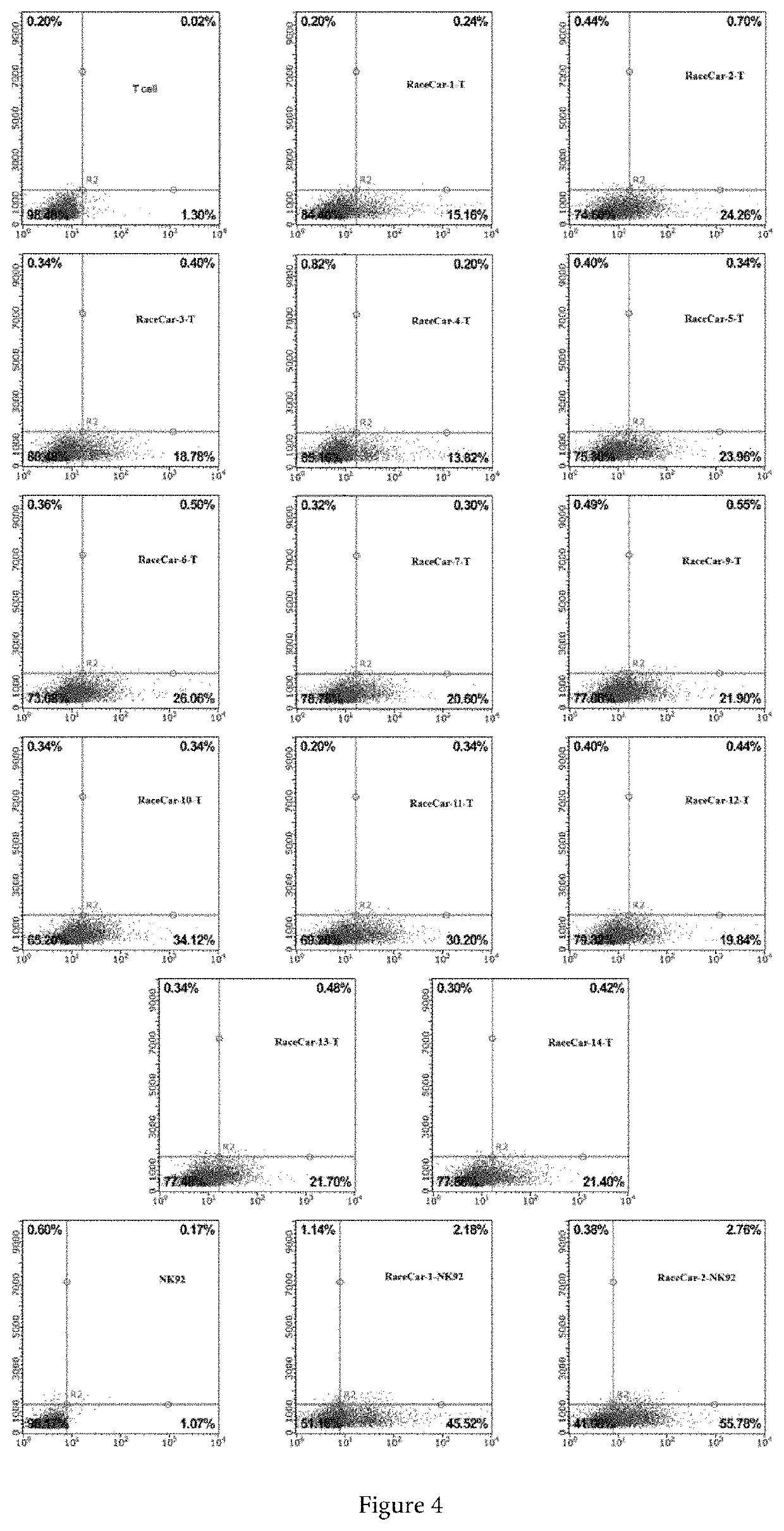Multi-target chimeric antigen receptor
a chimeric antigen receptor and multi-target technology, applied in the field of biotechnology, can solve the problems of insufficient il-2 production of all second-generation car to promote t cell proliferation, less effective clinical applications, etc., and achieve the effects of stable gene inheritance, low immunogenicity, and stable integration of genes
- Summary
- Abstract
- Description
- Claims
- Application Information
AI Technical Summary
Benefits of technology
Problems solved by technology
Method used
Image
Examples
example 2
FACS Analysis to Confirm RaceCar Expression on Cells
[0189]1.) RaceCar-1-NK92, RaceCar-2-NK92, RaceCar-3-NK92, RaceCar-4-NK92, RaceCar-5-NK92, RaceCar-6-NK92, RaceCar-7-NK92, RaceCar-9-NK92, RaceCar-10-NK92, RaceCar-11-NK92, RaceCar-12-NK92, RaceCar-13-NK92, RaceCar-14-NK92, RaceCar-1-T, RaceCar-2-T, RaceCar-3-T, RaceCar-4-T, RaceCar-5-T, RaceCar-6-T, RaceCar-7-T, RaceCar-9-T, RaceCar-10-T, RaceCar-11-T, RaceCar-12-T, RaceCar-13-T, RaceCar-14-T cells obtained in example 4, are suspended in PBS (phosphate buffered saline) respectively, the concentration of cells is controlled to be in the range of 1*10{circumflex over ( )}6 / ml.
[0190]2.) 1.5 μl of anti-hIL-15 PE conjugates is (R&D, IC2471P) is added into 200 μl of treated cells and incubates on ice for 30 minutes. The supernatants are removed by centrifugation and the cells are re-suspended by adding an equal amount of PBS (phosphate buffer saline).
[0191]3.) FACS analysis to verify RaceCar expressed on cell surface (FIG. 4). The horizo...
example 3
The Expression of RaceCar Demonstrated by Western Blot
[0192]1.) 1.2*10{circumflex over ( )}6 of Lenti-X-293T cells (Clonetech, 632180, hereinafter referred to as 293T for short) are laid in a 6-wellplate, and cultured overnight at the temperature of 37° C. and 5% of CO2;
[0193]2.) 293T cells described as above 1 are transfected respectively with vectorspFUGW-RaceCar-1, pFUGW-RaceCar-2,pFUGW-RaceCar-6, pFUGW-RaceCar-7 and pFUGW-RaceCar-10 mentioned in example 1 using lipofectamine 3000, and are named as RaceCar-1-293T, RaceCar-2-293 T, RaceCar-6-293T, RaceCar-7-293Tand RaceCar-10-293T and cultured with 5% of CO2 for 48 hours at the temperature of 37° C.
[0194]3.) 5×10{circumflex over ( )}6 of RaceCar-1-293T, RaceCar-2-293T, RaceCar-6-293T, RaceCar-7 -293T and RaceCar-10-293Twere taken and centrifuged for 10 minutes at 1500 R, and the supernatants were discarded.
[0195]4.) 200 μl of cell lysis solution (Beyotime, Shanghai, P0013B) was added onto each cells and incubated on ice for 30 min...
example 4
Packaging of Lentivirus with pFUGW-RaceCar and Cell Infection
[0201]1.) Taking RaceCar-1 as an example, 293T cells were cultured overnight to the density of 70-80% for transfection. pCMV-VSV-g, pCMV-deltaR8.91 (pCMV-VSV-G and pCMV-delta R8.91 were Addgene products)providing virus shell protein were mixed withpFUGW-RaceCar-1 prepared from example 1 according to the ratio of pCMV-VSV-g: pCMV-deltaR8.91: pFUGW-RaceCar-1=1:3:4 to obtain 40 ug of co-transfection plasmids.
[0202]2.) In a 15 ml of centrifugal tube marked as Tubel, co-transfection plasmids described as above 1 were added and serum-free DMEM were added up to 1.5 ml, and in an another 15 ml of centrifugal tube marked as Tube2,120 μl of PEI solution (Sigma, GF70215828,1mg / ml was added and serum-free DMEM (DMEM) was added up to 1.5 ml. Both reagents in Tube1 and Tube2 were properly mixed respectively. Then Tube1 was vortexed and PEI in Tube 2 was added into Tubeldrop by drop to obtain a plasmid-PEI mixture solution, and the solut...
PUM
| Property | Measurement | Unit |
|---|---|---|
| temperature | aaaaa | aaaaa |
| length | aaaaa | aaaaa |
| unit structure | aaaaa | aaaaa |
Abstract
Description
Claims
Application Information
 Login to View More
Login to View More - R&D
- Intellectual Property
- Life Sciences
- Materials
- Tech Scout
- Unparalleled Data Quality
- Higher Quality Content
- 60% Fewer Hallucinations
Browse by: Latest US Patents, China's latest patents, Technical Efficacy Thesaurus, Application Domain, Technology Topic, Popular Technical Reports.
© 2025 PatSnap. All rights reserved.Legal|Privacy policy|Modern Slavery Act Transparency Statement|Sitemap|About US| Contact US: help@patsnap.com



